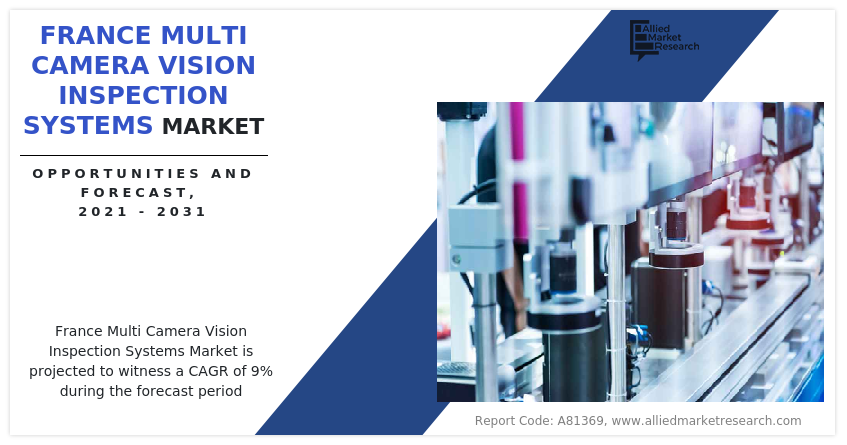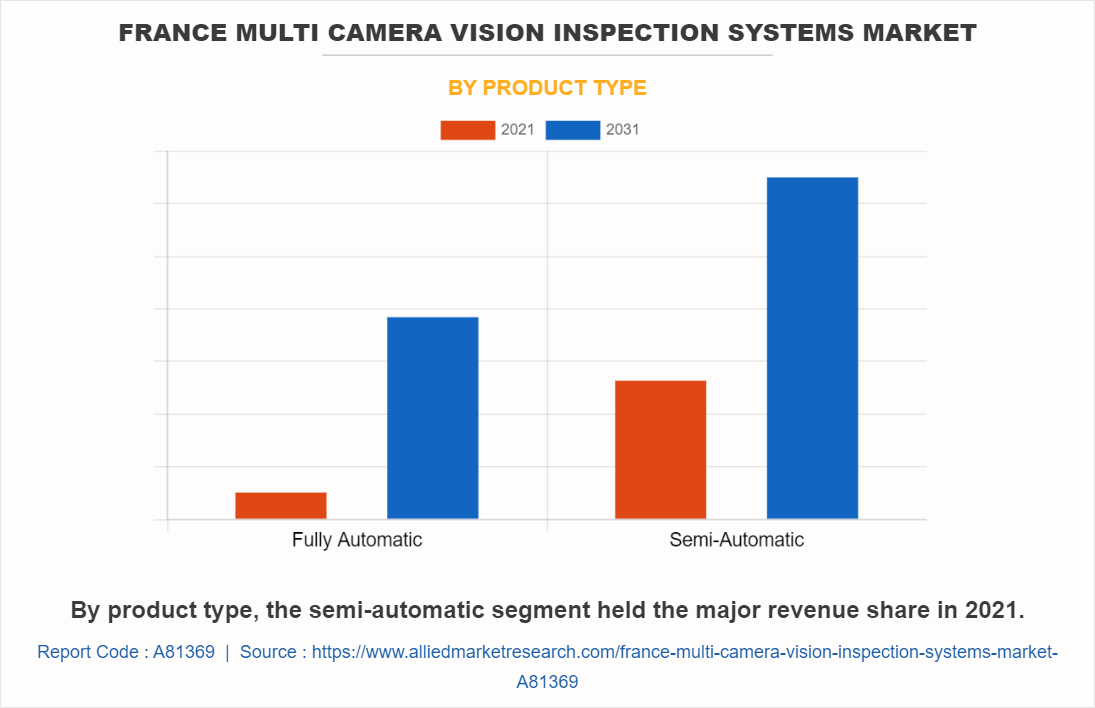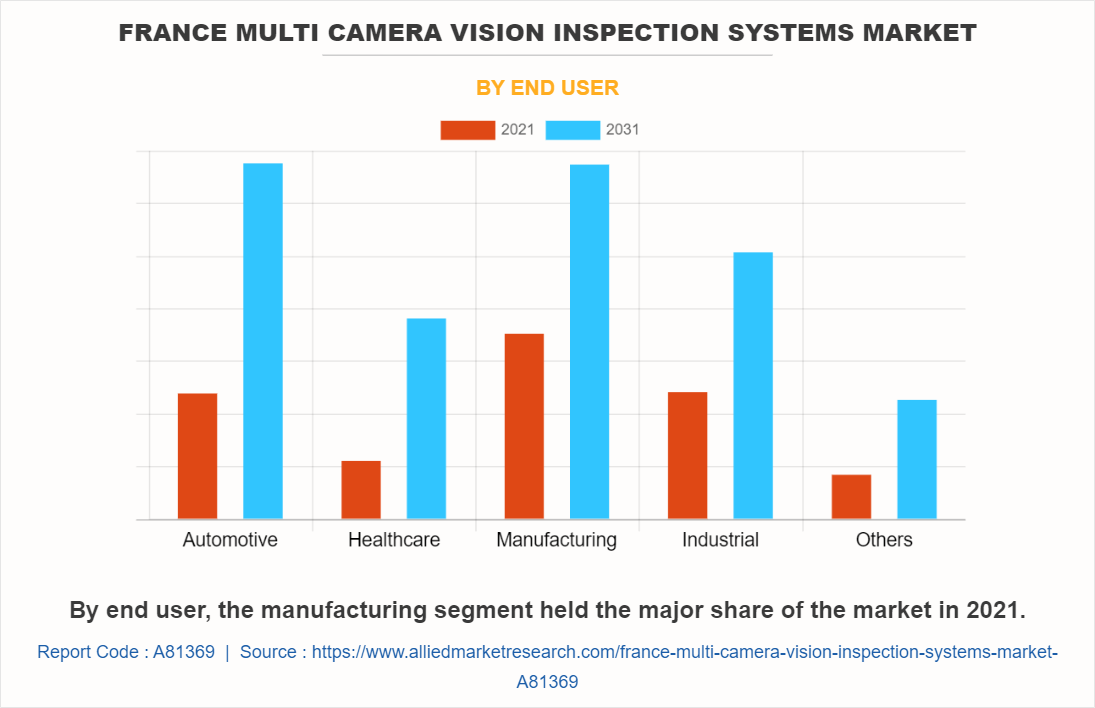The France multi camera vision inspection systems market has witnessed substantial growth during the forecast period. This is attributed to several driving factors. One compelling force that drives industries toward automation is a relentless pursuit of efficiency and precision. Across various sectors, the adoption of multi-camera vision inspection systems is on the rise. These fully automatic systems, requiring minimal human intervention, have gained significant popularity. They are meticulous in their inspection processes and offer a cost-effective solution for manufacturing and quality control.

Furthermore, semi-automatic systems are not anticipated to be overlooked as they provide a valuable link between full automation and manual inspection. They offer adaptability and flexibility, making them an ideal choice for industries that require customizable solutions, such as the healthcare sector. As a result, the demand for both types of products has increased, leading to market growth.
On the other hand, in this realm of innovation, market limitations persistently accompany progress, including substantial upfront capital needed for fully automated systems. Moreover, the hurdle of a skills gap arises, as the operation and maintenance of such systems necessitate a certain level of technical proficiency that not always be easily accessible.

Market opportunities, however, serve as a source of optimism. With the ongoing adoption of the Industry 4.0 revolution by various sectors, the incorporation of multi-camera vision inspection systems emerges as a lucrative prospect. Automotive, healthcare, manufacturing, and industrial industries find themselves at a pivotal moment of technological advancement, and this particular market serves as their guiding force.
The France multi camera vision inspection systems market is segmented into product type and end user. Further, on the basis of product type, the market is bifurcated into fully automatic and semi-automatic. By end user, it is classified into automotive, healthcare, manufacturing, industrial, and others.

The automotive sector heavily depends on these systems to guarantee the quality and safety of vehicles. As autonomous driving becomes more prevalent, multi-camera systems are no longer considered a luxury but rather an essential requirement. Similarly, the healthcare sector, which has strict quality control standards, has embraced these systems wholeheartedly. From pharmaceuticals to medical devices, the ability to meticulously examine intricate details and identify flaws is of immense value. Moreover, the manufacturing industry, which prioritizes operational excellence, views these systems as a valuable ally in ensuring the quality of their products.
Porter’s five forces analysis analyzes the competitive scenario of the France multi camera vision inspection systems market and the role of each stakeholder. These forces include the bargaining power of suppliers, the bargaining power of buyers, the threat of substitutes, the threat of new entrants, and competitive rivalry.
The threat of new entrants in the market is high due to presence of promising growth opportunities. With the increasing awareness of the advantages offered by multi-camera vision inspection systems, various industries are embracing this technology. Consequently, there is a possibility of emerging competitors aiming to exploit this growing trend. The bargaining power of buyers and the bargaining power of suppliers is high. Suppliers who possess proprietary technology and components for these systems hold considerable influence, while buyers from diverse industries apply pressure to secure favorable terms, particularly when making significant investments.
The consideration of the threat of substitutes is constant, although not immediately apparent. Despite the existence of alternative quality control methods that are not as advanced, the formidable choice lies in the rapid pace of technological advancement in multi-camera vision inspection systems. The competitive rivalry within the market is fierce, as both established players and new entrants strive to obtain a portion of the market. Furthermore, this competition is intensified by the rapid evolution of technology and the necessity to remain at the forefront of innovation.
A SWOT analysis analyzes the market scenario and covers internal strengths and weaknesses and external opportunities and threats. The market's strengths are evident, as it benefits from the rise in awareness of quality control's importance, particularly in industries such as automotive and healthcare. Moreover, technology's adaptability to various industries, whether in the form of fully automatic or semi-automatic systems, is a significant strength. However, the market has its weaknesses, such as the high initial investment required for fully automatic systems, which is a deterrent. In addition, reliance on specialized technical skills for system operation and maintenance is a potential stumbling block.
The Industry 4.0 revolution presents numerous opportunities that require advanced quality control measures and predictive maintenance. The integration of this technology with artificial intelligence and machine learning applications offers immense potential. However, it is important to recognize the potential threats. Alternative quality control methods, although less advanced, pose a threat to these systems. In addition, the market's attractiveness attracts new competitors, intensifying competition. As industries face budget constraints, manufacturers face pricing pressure, which is a significant threat.
Key players involved in the market include Cognex Corporation, Keyence Corporation, Omron Corporation, Basler AG, National Instruments Corporation, Teledyne Technologies Inc., Hermary Opto Electronics Inc., Datalogic S.p.A., ISRA VISION AG, and Matrox Imaging.
Key Benefits For Stakeholders
- Enable informed decision-making process and offer market analysis based on current market situation and estimated future trends.
- Analyze the key strategies adopted by major market players in France multi camera vision inspection systems market.
- Assess and rank the top factors that are expected to affect the growth of France multi camera vision inspection systems market.
- Top Player positioning provides a clear understanding of the present position of market players.
- Detailed analysis of the France multi camera vision inspection systems market segmentation assists to determine the prevailing market opportunities.
- Identify key investment pockets for various offerings in the market.
France Multi Camera Vision Inspection Systems Market Report Highlights
| Aspects | Details |
| Forecast period | 2021 - 2031 |
| Report Pages | 88 |
| By Product Type |
|
| By End User |
|
| Key Market Players | Xiris Automation, Usimax, Omron, Fuji Electric, Endress+Hauser, Leica, Keyence, Teledyne Technologies, Morpho, NIDEC-Shimpo |
The France Multi Camera Vision Inspection Systems Market is projected to grow at a CAGR of 9% from 2021 to 2031
Omron, Morpho, Endress+Hauser, Leica, Usimax, Teledyne Technologies, Keyence, Fuji Electric, Xiris Automation, NIDEC-Shimpo are the leading players in France Multi Camera Vision Inspection Systems Market
1. Enable informed decision-making process and offer market analysis based on current market situation and estimated future trends.
2. Analyze the key strategies adopted by major market players in france multi camera vision inspection systems market.
3. Assess and rank the top factors that are expected to affect the growth of france multi camera vision inspection systems market.
4. Top Player positioning provides a clear understanding of the present position of market players.
5. Detailed analysis of the france multi camera vision inspection systems market segmentation assists to determine the prevailing market opportunities.
6. Identify key investment pockets for various offerings in the market.
France Multi Camera Vision Inspection Systems Market is classified as by product type, by end user
Loading Table Of Content...
Loading Research Methodology...


